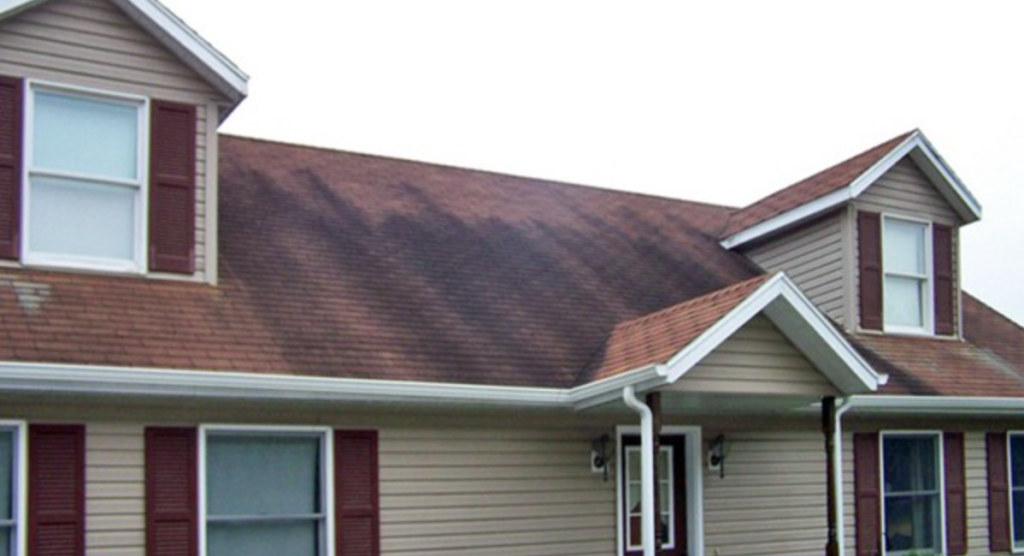
take pride in your home’s appearance and then one day you notice ugly black streaks or splotches on your Black Streaks On Roof . Alarmed, you think, what’s that on my roof and where did it come from?
Thank you for reading this post, don't forget to subscribe!Here’s a quick rundown of what it is, what causes it, and how Wet & Forget Outdoor erases those unsightly asphalt shingle stains.
Why is it growing on my roof?
Humidity, warmth, and a constant meal of limestone ensure that a bloom of roof algae will survive. Roof algae grip your shingles and hold on tight by secreting a glue-like substance.
In addition to roofs, it can grow on any moist or wet outdoor surface including walls, driveways, and sidewalks.
Why the dark streaks?
Roof algae contain a dark pigment that serves as a protective coating that shields it from the sun’s ultraviolet rays. This is what gives it the unattractive blackish color.
As the algae grows, gravity gradually pulls it down the Black Streaks On Roof creating the characteristic dark streaks. On light-colored roofs, these dark stains can raise indoor temperatures leading to an increase in your home’s cooling costs.
Is it harmful?
There’s a debate in the industry on whether the algae actually causes roof deterioration. Some say the act of constantly removing it with caustic chemicals, like bleach, may cause deterioration itself.
Some experts say that the algae may eat away at the shingle’s base causing the shingle to expand and contract with changes in temperature. This constant “movement” may shorten the life of your roof.
On cedar shakes and shingles, algae and moss are partners in crime. Moss, algae’s sidekick, is destructive to cedar shingles because it eats the wood, eventually causing rot.
Some homeowners and condo associations require roof algae removal on a regular basis.
How can I prevent it from happening?
Gloeocaspa magma is an airborne strain. The wind picks up the spores and will spread from one roof to another.
These spores travel from roof to roof, eventually settling in and grabbing hold. Some experts suggest that overhanging trees should be trimmed to slow the algae’s growth, but this is only a temporary solution.
To maintain your home’s appearance, you should clean your roof every 6 to 18 months.
how to remove mold from roof shingles

Finding mold on your roof or under the shingles can be quite alarming. The best way to respond to this is to get a thorough mold inspection in the attic to determine fully the condition of your roof.
Molds are not harmful to the roof but they will definitely make the roof look bad. Typically, a moldy roof consists of algae, moss and mold.
Algae may look slimy green, black or in blue-green streaks. Mosses are tiny plants that grow in dense vibrant green mats that can cover your roof. Roof molds are typically from inside the attic.
Mold growth is often due to the presence of roof leaks.
How To Clean Your Roof
There are several ways to clean your roof from moss, algae and mold. Use these tips as your guide when cleaning your roof.
- Cleaning your roof can be risky. You have to go on top of it. Make sure to secure yourself in a harness. Most people will get help from a roof repair company for better results.
- Pressure washers may be easier to use in cleaning your roof but they can damage the shingles. Use a hose attached with a nozzle instead.
- You may spray wash the roof with 1 part water and 1 part bleach to clean off the algae. Let is sit for around 60 minutes before rinsing.
- If you find bleach and water solution weak for your moldy roof, you may use trisodium phosphate. Mix a cup of it for every gallon of water.
- There are other commercially available cleaning solutions in the market. Take note however of the labels and make sure you’re using the right product for your roof.
Some homeowners are considering roof waterproofing in order to prevent moisture and mold growth. While it’s good to initiate for your roof’s maintenance, getting help from an exceptional roofing company is still your best option.
white powder on roof shingles
Your roof can collect more than just dirt and leaves. Left to its own devices, your roofing system could also develop something more unsightly for your home: algae. Black Streaks On Roof A roof may develop different types of algae, lichens, and fungi as bacteria take over. Many homeowners mistake algae for “roof mold.” In most cases, however, it is really a blue-green type of algae and when it dies it leaves dark streaks on your roof.
Algae can cause unsightly stains and growths on your new roof. It will continue to worsen year after year until you invest in professional cleaning. You’ll find everything you need to know about roof algae here, in this comprehensive guide from the experts at Mr. Roof.
Our residential roofing contractors want you to learn how to recognize roof algae, understand the potential hazards it could pose to your home, and know when to call in the professionals for deep cleaning, roof repair, or roof replacement. We offer free roof inspections at locations throughout the country.
